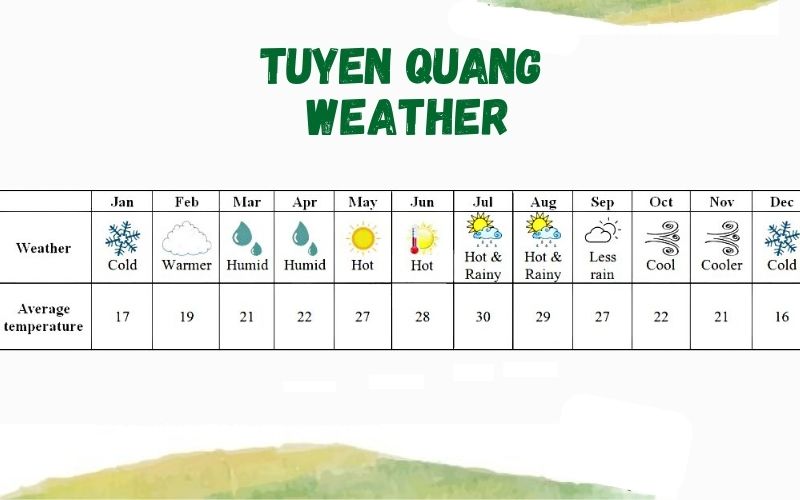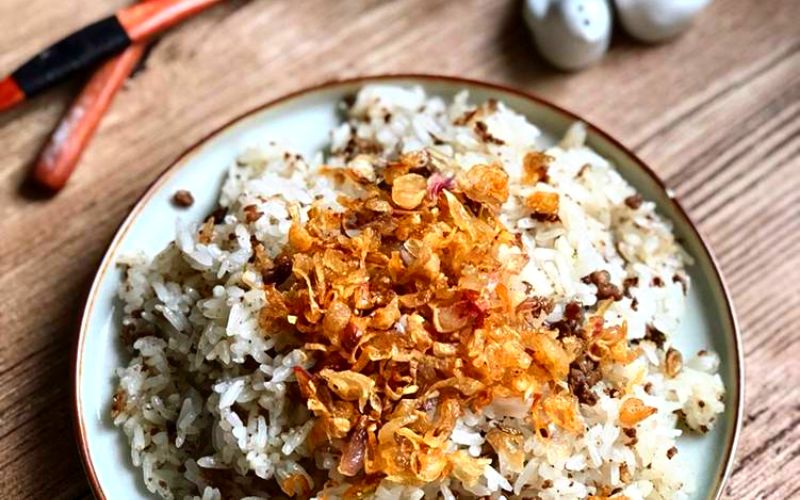Tuyen Quang is a mountainous province in northeastern Vietnam, located in the valley of the Lo River, a tributary of the Red River. It is the neighbor of Ha Giang Province to the North, Bac Kan, and Thai Nguyen Provinces to the East, Yen Bai Province to the West, and Vinh Phuc, and Phu Tho Provinces to the South. This province, with majestic elevated mountain peaks exceeding 2,000m above sea level, is home to several ethnic groups, including Kinh, Tay, Dao, and Nung, with the Kinh ethnic group accounting for more than half of the province’s population.
General Information
Tuyen Quang has been developing more and more with over 50% labor force at young ages, which has been the strength of this mountainous province in economic development, covering an area of 568,800 hectares with the majority of the land spent on agricultural purposes. Moreover, the region’s face has been evolving significantly positively with the appearance of more and more industrial zones and the local committee’s enthusiasm in calling for external investment.

Tuyen Quang location
Tuyen Quang is “the capital city of the revolutionary” in Vietnamese. Tan Trao and Son Duong were historically used as locations for historical events and meetings related to national destiny held by the Central Party and Uncle Ho. Tuyen Quang people had to bear the exceptionally important mission of building and protecting the Uncle Ho, Party Committee, National Assembly, Government, and Battlefront, as well as Central Ministries and Lao revolution headquarters, during the very first difficult time of national magical revolutionary. Party Committee and Tuyen Quang people played a significant contribution to the battle to gain national independence.
The province owns 519 relics of history, culture, and landscape, including one special national relic, 117 relics at the national level, and 181 relics at the provincial level. Tuyen Quang is not only associated with the process of national formation but also with the tangible and intangible cultural heritage of the ethnic communities who have lived in this land for a long time. Therefore, Tuyen Quang hopes to provide tourists with unforgettable experiences.
Weather in Tuyen Quang & Best Time to Visit

Weather in Tuyen Quang & Best Time to Visit
Tuyen Quang features a humid subtropical, dry winter climate. Throughout the year, the temperature ranges from 34.2°C (93.56°F) to 13.9°C (57.02°F), with an average yearly temperature of 24.0°C (75.26°F). The annual rainfall totals nearly 1674.0 millimeters (65.91 inches). The wet season in Tuyen Quang is hot, oppressive, and overcast, while the dry season is pleasant and mostly clear. The best months to visit Tuyen Quang are November to April when the weather is pleasant and ideal for trekking and hiking.
Getting to Tuyen Quang
Tuyen Quang is about 150 kilometers from Hanoi, so getting there by High Way 2 is simple. You can easily catch a bus from My Dinh Bus Station, which takes about 3 hours to get to Tuyen Quang. Furthermore, if you are riding a motorcycle, proceed from Pham Van Dong to the Noi Bai – Phuc Yen crossroad, turn left onto National Highway 2 to Phuc Yen, Vinh Yen, and continue straight onto National Highway 2 via Phu Tho, Tuyen Quang. Besides, we highly recommend hiring a car with a driver to travel faster.
Where to stay in Tuyen Quang
Tuyen Quang has a wide range of accommodation options. Depending on your needs, you can choose from low-cost motels, homestays, and high-end hotels at reasonable rates. If you book your trip through us, you won’t have to worry about lodging.
What to See in Tuyen Quang
Historical Relic of Tan Trao
Tan Trao, which served as Vietnam’s revolutionary base prior to August 1945, is the most well-known destination on a Vietnam discovery trip, not only for its historical significance but also for its beautiful natural landscape.

Historical Relic of Tan Trao
Tan Trao is a small valley located in Son Duong district, 41 kilometers from the center of Tuyen Quang town, where the Communist Party of Vietnam held a national party conference on August 13, 1945, to discuss the plan for a general uprising.
When coming here, visitors can have the chance to visit some remaining historical sites: Tan Trao Communal House, Hong Thai Communal House, and Tan Trao banyan tree. Tan Trao also has many caves, rich resources, and beautiful scenery that can captivate visitors at first glance.
Na Hang Ecotourism Area
There are a few destinations in Northern Vietnam that can meet the expectations of adventurous travelers who want to explore and discover mysterious caves and primeval forests, such as Na Hang. This area is located in the northern part of Tuyen Quang, 110 kilometers from the city center. Each cave, stream, and waterfall has its own legendary story, some of which have been incorporated into poetry and songs.

Na Hang Ecotourism Area
This is the confluence of the Gam and Nang rivers, adjacent to Ba Be Lake and surrounded by majestic mountains and inspiring land. You can also rent a small boat and travel around to see the Pac Ta and Pac Vang temples, as well as Pac Ta Mountain, which is the highest point in Na Hang.
Additionally, Tat Ke-Ban Bung Nature Reserve is the homeland of a thousand kinds of fauna and flora across 42,000ha. The term “electronic commerce” refers to the sale of goods and services over the Internet.
Moreover, Na Hang is very rich in ethnic culture with the residents of many ethnic minority groups such as Dao, Tay, Nung, and San Diu. Tourists can take cultural tours to learn about ethnic groups because of the house on stilts covered in palm leaves and specific traditional cultural features.
My Lam Mineral Stream
This well-known stream is located in Yen Son district, Tuyen Quang province, 13 kilometers south of Tuyen Quang’s central town. My Lam Mineral Stream entices visitors with mineral mud baths, hot mineral water baths, and breathtaking natural beauty.

My Lam Mineral Stream
The stream has sulfur mineral water underground, which was discovered in the 60s. Until now, water has been shown to contain high levels of bicarbonate, calcium, sodium, and potassium. Taking a bath in 40-42oC water helps visitors relieve stress and pressure while also restoring relaxation and pleasure. This method, too, can relieve arthritis pain and neuralgia, bringing joy and health to many patients. Aside from tangible values, local people take great pride in their intangible values, which have existed for hundreds of years.
Traditional Festivals
Long Tong festival (Tay ethnic people)
Long Tong festival, which translates as “crop praying festival,” is an important event to kick off the new year. It is always held on the 8th lunar January with the meaning of praying for good weather conditions and productive harvests.

Long Tong festival
The beauty of the villages hidden in the foothills and covered in mists will undoubtedly provide visitors with an unforgettable experience.
Mid-Autumn Festival
The festival takes place every year on Mid-Autumn occasions. This is one of the most important festivals on your trip to Vietnam. The festival includes interesting activities such as organizing the Mid-Autumn Festival for children, introducing Tuyen Quang province to visitors, and modeling dresses and costumes related to Vietnamese Mother Goddess worship.
At the festival, there will be a lantern-making contest, a fruit tray decoration contest, and music shows. Moreover, the sparkling gaudy colors from the giant lantern, in particular, will catch the attention of both local and international participants, particularly many children for the first time and leave them in a beautiful phase of their lives.
What to Eat in Tuyen Quang
Tuyen Quang is famous for its diverse cuisine. There are some food specialties that can leave an indelible impression on your mind.
Black pork

Smoked black pork
In Na Hang, a district of Tuyen Quang, this is a popular dish among ethnic minorities. The black pork is firm and delicious. Because, unlike regular pigs, the black pig is raised by natural grazing without being confined.
Steamed rice rolls

Steamed rice rolls
In contrast to other places, the crust to make steamed rice rolls in Tuyen Quang contains ingredients from three different types of rice. People soak them overnight before being milled and coated right before customers eat them, maintaining the crust’s softness, but keeping it still tough and thin. Regarding the filling, a few spices are also added to make the taste more alluring and unusual in addition to wood ear, shiitake mushrooms, meat, or shrimp paste.
Five-color sticky rice

Colorful sticky rice
The multi-colors of this food are the specialty, and they are very eye-catching. You can find this food during Tay ethnic group worship holidays. The stream sticky is made of glutinous rice and is very fragrant, with five colors representing Metal, Wood, Water, Fire, and Earth: white, yellow, blue, red, and purple. There is another explanation for the colors soil, water, clouds, rain, and sunshine. Tay’s vegetable garden provided all of the ingredients for this dish.
Sticky rice with ant eggs

Sticky rice with ant eggs
This rustic food may sound strange to some, but if you try it once, you will definitely want to have a second bite because of the delicious taste of the sticky rice and the fat of the ant eggs mixed with onions and dill.
Corn liquor in Na Hang

Corn liquor
Like other mountainous areas, Tuyen Quang has its own kind of wine. This wine is made from maize and leaves yeast, as well as 20 herbs such as forest peppers, cinnamon, and licorice, and is distilled and steeped for a long time using traditional Na Hang methods. This wine not only has the sweet taste of corn liquor, but it also aids in the treatment of certain diseases such as rheumatism.
We hope this article provides you with useful information for your trip to Tuyen Quang. Contact us to find out more about this beautiful town!
